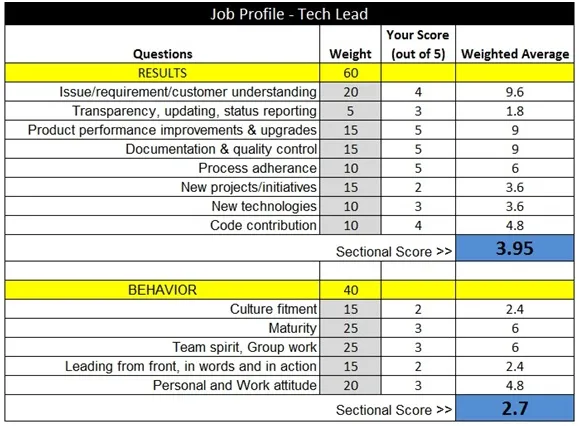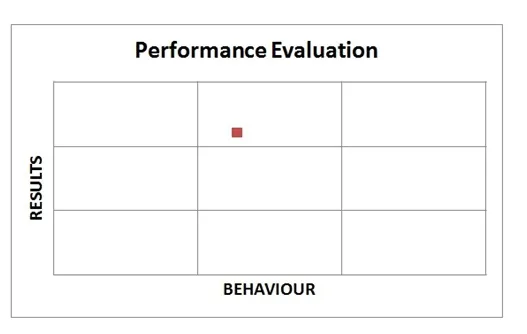A foolproof performance appraisal matrix for startup employees
Every startup wants to grow, who doesn’t? But with growth, every company needs to inevitably add more managers, more heads, more leaders, basically a larger workforce. This creates a frantic need to hire fast and more importantly the need to hire the right people. But in this urgency of recruitment drives, it’s extremely important to take hiring decisions with utmost care and caution, because the people that you hire, especially in top positions, will directly impact how fast/successfully you will grow.

However, it’s not always easy to gauge the competency of a candidate from the interview(s) itself, right? So, you don’t have a choice but to weigh your options and give people a chance to prove their mettle – which brings you to the often controversial “Performance Review” cycles, KRA lists, and the appraisal meetings at the end of the year. But what about the time in between, those months when results weren’t met, targets weren’t achieved?
This melee of talent acquisition and talent management problems have often put me in a position where I thought I had hired the “ideal person” but things didn’t go as planned – when I reviewed things at the end of the year(s). My expectations in terms of output and performance just weren’t met. Now normally, wisdom and wise men, both have recommended that such situations demand a “talk”. Just sit them (non-performing employees) down, and have a tête à tête to see how we could deal with this. Find that win-win balance, get that motivation engine started.
But, having had my fair share of talks in the past, I’ve come to realize that these review talks are not enough to point the crux of the problem to an employee, as effectively as it should. I needed something more visual that would convey what my concerns were, and where does the employee need to focus on. Moreover, I also needed something that would tell me what to expect from this employee in the near future.
So, I decided to put my thoughts to paper (of course, with some inspiration online), the result of which is the matrix below:

Results and Behaviour
I feel that people and their performance on the job, can always be categorized into 2 broad categories – Results, Behaviour. There is nothing that can slip out of these categories, if you list down the things you expect the employee to achieve in the job.
Results mean how far the employee has been able to achieve the goals or KRAs that were set when you hired him. The factors in this category would be more objective in nature, or quantifiable with numbers or accomplishments. For instance, targets achieved, calls made, features launched, bugs solved, issues resolved, communication skills, writing abilities, domain knowledge, etc.
Behaviour, on the other hand, includes the work ethic of the individual, his equation with teammates, ability to adapt to the work culture, attitude on the job and towards the company’s vision, ability to understand the larger goal, skill to lead or be lead, etc.
Under any circumstances, Results alone can never be enough to judge or decide if someone has been competent on their job or not. Sometimes the employee may need time to grasp the change around him and with a little support will be a better performer in the future. This means, Results as well as Behaviour, both go hand-in-hand when it comes to looking at the employee’s performance holistically. One cannot be evaluated without the other, else you’re bound to get a 2D evaluation.
This is where the above performance matrix helps me look at things more clearly – it practically works like a magician’s Crystal Ball. It gives more clarity to the employee on where she stands, when looked at in a combination of Results + Behaviour, and where is improvement needed. It also serves as a guide to the employer on what to expect from the employee in the future.
When should the employee be evaluated?
Just using the matrix is not going to solve the problem for you. I’ve learned that having annual reviews, is actually counter productive overall to all parties involved. Why? Let me explain:
A. the employee could have done so much to improve, if only she knew earlier what’s on your mind
B. the company would have saved so much money, while waiting for magic to happen
C. lack of communication could probably deteriorate the situation or leave no more time to either parties, when the evaluation is eventually done
D. classic case of, should-have, could-have, what-if, etc. Now it’s too late!
Instead, ideally, there should be regular and predetermined time intervals when reviews should be conducted – where both parties have clear knowledge of what is expected within this duration from the employee, in terms of Results & Behaviour. So, recently, I’ve started to implement the following cycle for reviews.
1st Review: at the end of 1 month from the employee’s date of joining
2nd Review: at the end of the 2 months from the 1st review date (3 months from date of joining)
3rd Review: at the end of 4 months from the 2nd review date (6 months from date of joining)
4th Review: at the end of 8 months from the 3rd review (12 months from date of joining)
After each period, we revisit the goals and expectations, so that the employee is clearly aware of how much she needs to achieve, what she needs to focus on and where she needs to continue consistently.
Having completed this cycle once, you don’t need to repeat it in short intervals, but a half-yearly one will do just fine! But anything longer than that, can be risky, in my opinion.
The reason for decreasing the frequency from 3 to 6 months is the assumption that by this time, the employee and the employer have both understood each others expectations well enough to work towards a better performance.
What should I do in different scenarios?
- Wrong Hire:It’s best to let the employee go. There is no hope of things getting better in the future so it’s better to end it as early as possible.
- Hard Nut:Clearly competency isn’t the issue here. I would usually deal with such employees by speaking to them about growth. You don’t want people with poor attitudes in charge of teams and the only way to grow is to improve your work ethic. If the employee is serious about his career, he/she will usually make the effort to change.
- Wrong Role:I give such employees an option to choose a different role where they think they would be able to perform better. Dedicated employees are hard to find so if you can use them in another role, why not? This way, you can still not lose the time, effort and investment which went into the employee so far.
- Ideal Fit:Not much to say here. Congratulations, don’t let her go!
Plotting positions in the matrix, based on scores:
The ideal way to use the matrix would be to combine it with a clearly listed set of items in each category, so that you can pinpoint the good, bad and the ugly, while retaining some numerical scores to quantify your review.
Using simple weighted average methods, you can create a review list which gives you an axis based point system, helping you plot the employee’s position in the matrix.
Here’s an example for a Tech Lead:


Sticking to this matrix while evaluating employees, has helped me immensely. Setting the right expectations for both parties has become so much easier. Even a result oriented department like sales has achieved a lot more clarity. I have been able to show them areas of improvement beyond just numbers that has eventually made them more productive.
I hope this article helps you out with your employee evaluations. If you have any questions or would like us to write on a certain topic or wish tell us anything else under the sun, do leave a comment below.

About the author:
Jay is the Chief “Go-to” Officer at sumHR. He spearheads sales, support, product management and all things ‘creative’. Before this, he’s worked in the startup teams at Burrp! and Directi.com. He loves writing whenever he gets the chance, and mostly writes about sumHR, startups, leadership, motivation, inspiration and of course, HR best practices.







